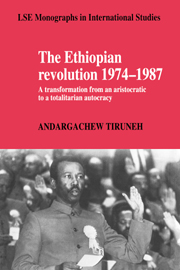 The Ethiopian Revolution 1974–1987
The Ethiopian Revolution 1974–1987 Book contents
- Frontmatter
- Contents
- List of maps and tables
- Acknowledgements
- List of abbreviations
- Map 1 The Horn of Africa
- Map 2 Administrative divisions
- 1 The background to the emergence of the structural crisis
- PART I THE COLLAPSE OF THE OLD-STATE (JANUARY–NOVEMBER 1974)
- PART II THE FORMATIVE YEARS OF THE POST-REVOLUTIONARY ORDER (DECEMBER 1974–FEBRUARY 1977)
- PART III CONSOLIDATION OF POWER (FEBRUARY 1977–SEPTEMBER 1987)
- 8 The elimination of internal and external threats to Mengistu's power
- 9 The formation of the Workers' Party of Ethiopia
- 10 The formalization of power through the 1987 constitution: ‘organizational operation’ in action
- 11 Conclusion
- Postscript
- Appendix: chronology of events
- Notes
- Bibliography
- Index
- LSE MONOGRAPHS IN INTERNATIONAL STUDIES
10 - The formalization of power through the 1987 constitution: ‘organizational operation’ in action
Published online by Cambridge University Press: 18 December 2009
- Frontmatter
- Contents
- List of maps and tables
- Acknowledgements
- List of abbreviations
- Map 1 The Horn of Africa
- Map 2 Administrative divisions
- 1 The background to the emergence of the structural crisis
- PART I THE COLLAPSE OF THE OLD-STATE (JANUARY–NOVEMBER 1974)
- PART II THE FORMATIVE YEARS OF THE POST-REVOLUTIONARY ORDER (DECEMBER 1974–FEBRUARY 1977)
- PART III CONSOLIDATION OF POWER (FEBRUARY 1977–SEPTEMBER 1987)
- 8 The elimination of internal and external threats to Mengistu's power
- 9 The formation of the Workers' Party of Ethiopia
- 10 The formalization of power through the 1987 constitution: ‘organizational operation’ in action
- 11 Conclusion
- Postscript
- Appendix: chronology of events
- Notes
- Bibliography
- Index
- LSE MONOGRAPHS IN INTERNATIONAL STUDIES
Summary
THE DRAFTING AND ADOPTION OF THE CONSTITUTION
The second congress of COPWE, which founded WPE, met between 5 and 9 September 1984, and adopted the central report of COPWE and the Programme of the Party both of which were submitted to it by the chairman of COPWE (Mengistu Haile-Mariam). Those documents, which duplicated each other, laid down the main features of the would-be constitution of PDRE for the first time. The most striking aspects of those documents included the following:
In the endeavour to usher in the new political order, the primary task is to establish PDRE under the leadership of WPE. The task of the government of PDRE will be to consummate the ongoing NDR and proceed with the construction of socialism. The broad masses have enjoyed democratic rights in peace by abolishing the anti-development monarchy.
The structure and operation of PDRE shall be in accordance with the Marxist–Leninist principles of government structures and operations. Thus, the characteristic features of the republic will be proletarian internationalism, democratic-centralism, socialist legality, and active participation of the people.
The structure of the government of PDRE shall be unitary and be based on the realities of the country's economy and shall take into account the locality of the nationalities. The organization of state power from the lowest to the national levels shall be filled by individuals elected by the people. In the construction and operation of the republic, WPE shall give special emphasis to guaranteeing that the sovereignty of the working class is progressively ensured in the organization of state power and that the participation of the nationalities in them exists.
[…]
- Type
- Chapter
- Information
- The Ethiopian Revolution 1974–1987A Transformation from an Aristocratic to a Totalitarian Autocracy, pp. 265 - 298Publisher: Cambridge University PressPrint publication year: 1993
